Although the Galapagos Islands, Atacama and Torres del Paine National Parks are well known among travelers from
North America, most people don’t know that there are more than 300 other beautiful national parks, protected sanctuaries and nature reserves in
South America. Some are more accessible than others, some are quite small, and others are bigger than some countries, but all are generally well-maintained and boast some of the most spectacular scenery and wildlife in the world.
Parque Nacional Natural Tayrona (Tayrona National Natural Park), Colombia
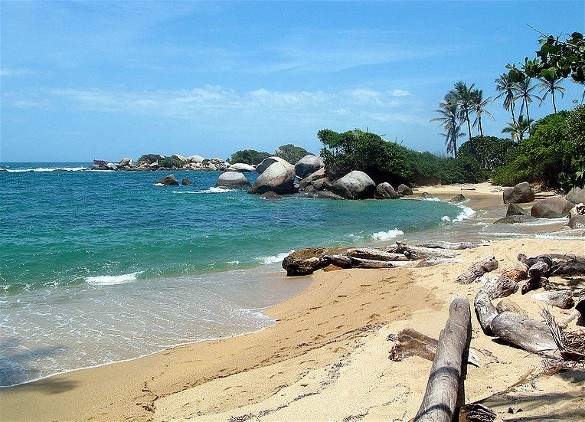
The second most-visited park in
Colombia, Tayrona extends from the northern shores of the Caribbean to the Sierra Nevada de Santa Marta, the highest coastal mountain range in the world. Because two ecosystems make up the park, it is home to 180 species of mammals and 300 species of birds and, since the park encompasses part of the Caribbean sea, hundreds of species of coral, fish, sponges, mollusks and other marine life. Wildlife viewing excursions are very popular in the park and visitors have spotted black howler monkeys, titi monkeys, iguanas, bats, deer, jaguars and oncillas, a relative of the ocelot. Birdwatching is also popular and visitors may be lucky enough to see eagles, red woodpeckers and Andean condors, the second largest bird in the world.
‘Tayrona is considered to be one of the most beautiful parks in coastal South America.”
It has tropical and high mountain climates, sandy white beaches bordering turquoise waters, towering snow-capped mountains, rocky atolls, archaeological ruins, and dense vegetation ranging from low mangrove and palm stands to high cloud forests. Activities available to tourists include snorkeling, scuba diving, surfing, swimming, horseback riding, camping and hiking. The park offers campsites, tent and hammocks rentals as well as more upscale eco-cabins as accommodation.
>> Read why you should ignore everything you’ve heard about Colombia and go there now
Parque Nacional Canaima (Canaima National Park), Venezuela
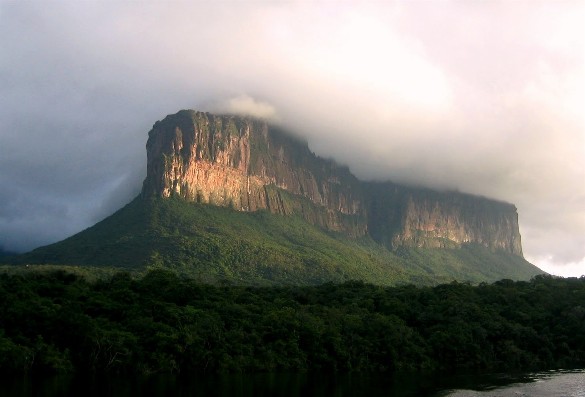
The highlight of the sprawling 30,000 square kilometer (11,583 square mile) park located in southeastern
Venezuela is undoubtedly Angel Falls (Salto Angel), the highest waterfall in the world, but the park is also famous for its numerous smaller waterfalls, peaceful lagoons, rushing rivers, rainforests, jungles, wildlife and the famous table-top mountains of the region known as tepuis. Canaima was designated as a UNESCO World Heritage site in 1994 to protect its unique flora, fauna and topography including the breathtaking tepuis, whose summit plateaus are so isolated that many of them developed their own ecosystems, with plants and animals found nowhere else in the world, including one-of-a-kind orchids and bromeliads. These majestic giants rise out of the landscape throughout the park and are remnants of the super continent of South America and Africa.
“The highest tepui in the park is Mount Roraima. “
This landmark inspired the novel The Lost World by Arthur Conan Doyle. Guided tours and multi-day excursions can be arranged from Caracas or Ciudad Bolivar, the closest town to Canaima. Guided activities may include hiking, bird and wildlife watching, swimming under the waterfalls, boating, visiting the communities of the indigenous Pemon Indians and trekking up the tepuis. The park is remote with few drivable roads but can be explored on foot or by small airplane or boat.
Parque Nacional Los Glaciares (Glaciers National Park), Argentina
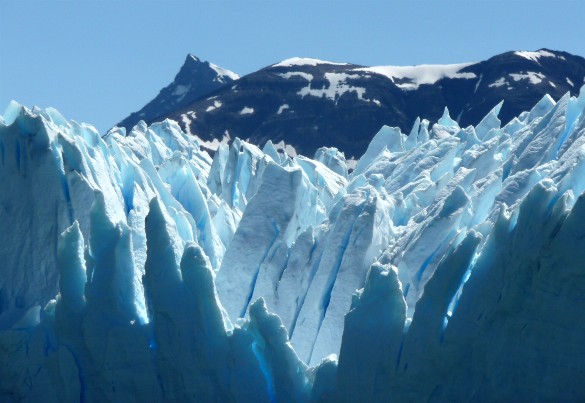
Although this park is quite well known since it is home to the Perito Moreno Glacier, it is worth revisiting because the government recently completed extensive renovation work throughout the park, including a new and impressive multi-level walkway in front of the glacier. Another reason to visit soon is that, due to climate change, the glaciers are melting at an accelerated rate and many are expected to disappear completely in the next few years. Although Perito Moreno is one of the few glaciers in the world that is advancing, rather than receding, the smaller glaciers are melting so quickly that they are changing the level of water in the park’s lakes, which in turn is affecting the micro-climate.
“The park, located in the southwest of Patagonian Argentina on the Chilean border, is home to 47 glaciers (currently 30% of the park is covered in ice).”
It also encompasses towering snow-capped mountains, multi-hued glacial lakes and rivers and sub-Antarctic forests and steppes. The park is one of most well-maintained and organized in South America and it is possible to hike, take a boat ride up to a glacier face, ice-trek with crampons and kayak across a lake all in one day. Other activities available are hot air balloon rides, horseback riding, mountain climbing, photography safaris and trout fishing. Day tours, transportation and activities can be easily arranged from the nearby town of Calafate.
Parque Nacional Vicente Pérez Rosales (Vicente Pérez Rosales National Park), Chile
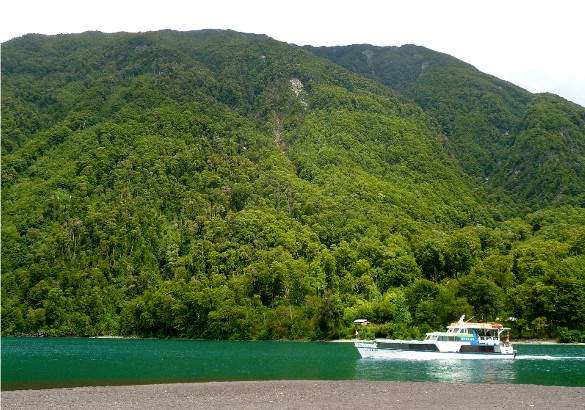
Located in the stunningly beautiful lake district of southern Chile, Vicente Pérez Rosales Park is one link in a chain of national parks and protected areas (including Chile’s Puyehue National Park and Argentina’s Nahuel Huapi National Park and Lanín National Park) which covers 5,800 square miles and is almost entirely situated in the Andes Mountains. One of the most spectacular sites of the park is the almost perfectly symmetrical snow-capped cone of Osorno, the active 8,700-foot volcano which towers over the Todos los Santos (All Saints) and Llanquihue lakes at the western entrance. It is usually possible to trek up one of the volcanoes in the park, but because of varying heights, constantly changing mountain micro-climates and levels of difficulty, climbers must always carry sufficient equipment and be accompanied by a certified guide. Besides Osorno, the park is home to Puntiagudo at 8,169 feet, Picada at 5,610 feet and Tronador at 11,453 feet.
“Volcano treks here normally require a 2-3 day excursion.”
The park is also famous for its thermal baths, deep blue glacial lakes and lagoons, lush forests and powerful rivers and waterfalls. Activities include kayaking, hiking, group boat tours, rafting, skiing, volcano trekking, mountain climbing, bird-watching and horseback riding. Day trips or multi-day trekking excursions can be arranged at nearby Puerto Montt or Puerto Varas or directly with the park’s tour offices.
>> Read about where to go wine tasting in South America, including Chile
Parque Nacional Iguazú and Parque Nacional do Iguacu (Iguazu National Park, Argentina/Brazil)
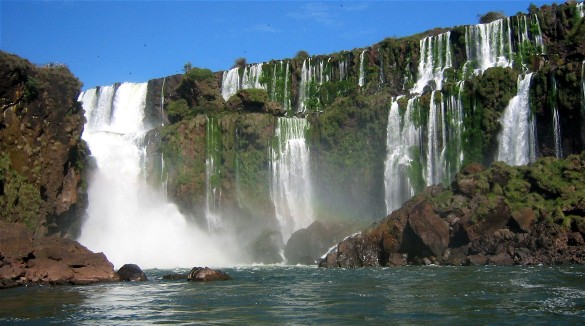
The setting for the movie, The Mission, breathtaking Iguazú Falls spans two countries and two national parks stretching across Argentina and Brazil. Both parks are clean, well-maintained and relatively close together. The park on the Argentine side is larger and encompasses more falls with 275 separate cascades, but the park on the Brazilian side allows visitors a closer look at the falls and is also near the fascinating waterfall-powered hydro-electrical plant, Itaipú, the largest power plant on earth, which hosts hourly tours.
“The falls are not only impressive for their size (the main falls are 1.8 miles wide and 263 feet high), but for their distinct characteristics. “
Several falls are double-tiered, others fall over bright green hanging vines like transparent veils, others, like the largest, La Garganta del Diablo (The Devil’s Throat) seem to be bottomless due to the large amount of mist generated by the power of the falls. The falls are so impressive that Eleanor Roosevelt, when visiting the falls for the first time, reportedly blurted out “Poor Niagara!” Visitors to the Argentine side can buy a two-day pass that allows full access to the park, including the Rainforest Ecological Train that provides transportation to many walkways. Activities and tours may be booked in the town of Iguazú or at the park entrance and include jeep safaris, trail hiking, wildlife viewing (jaguars, ocelots, tapirs, lizards, toucans, Capuchin monkeys and multi-colored butterflies), boat rides which take passengers directly under the force of the falls, rafting and horseback riding.
>> Discover where to go in Brazil besides Rio
>> Check out 8 reasons to go to Argentina now
Parque Nacional Cotopaxi (Cotopaxi National Park), Ecuador
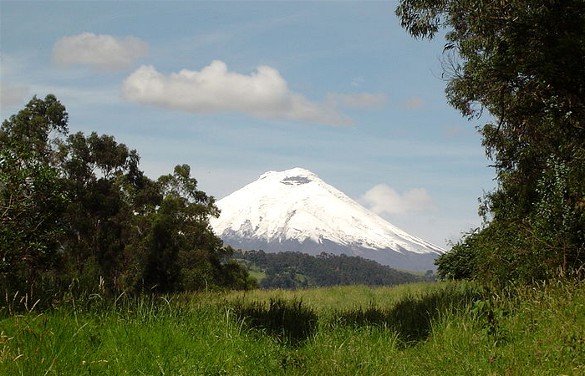
Although many visitors make a beeline from Quito, Ecuador to the Galapagos Islands, one of the most stunning sights in South America is situated in the eastern Andes in Cotopaxi National Park. The most-visited national park on the mainland, Cotopaxi Park is named for one of the world’s highest active volcanoes at 19,348 feet which sits at the park’s center. The mountain has been worshiped as a god for thousands of years by indigenous populations who built mountainside platforms to perform rites and to make offerings, the ruins of which can still be seen today. The volcano famously erupted during a battle between locals and Spanish conquistadors, who, being unfamiliar with volcanic activity on such a large scale, abandoned their quest to conquer the region and flew in terror. Many park visitors trek up the volcano, stopping at the refuge, a rest area about an hour’s climb up from the parking lot; to reach the summit, conditions permitting, generally requires between 5-7 hours, but the incredible views from the top are worth the trek.
“Cotopaxi also has one of the few equatorial glaciers in the world, as well as pristine lakes, forests and diverse wildlife.”
Condors, pumas, spectacled bears, Andean foxes, orange-headed caracaras (birds of prey), llamas, frogs, humming birds and families of wild horses roam freely throughout the park. Activities include mountaineering, volcano trekking, camping, hiking, bird-watching, horseback riding and mountain biking. Day tours and climbing excursions can be arranged from Quito or the nearby town of Latacunga.
Parque Nacional de Manú (Manú National Park), Peru

Even before the government of Peru designated the area a protected site, the 3.7 million acre park was well-conserved due to its remoteness. Today it is a UNESCO World Heritage site and is the largest park in Peru when including the biosphere reserve area. It is also one of the most diverse parks ecologically due to its topographical and climatic variation, which supports more than 15,000 known species of plant life, over 1,000 species of birds, over 600 species of animals and 2,400 species of insects. Because Manu is so untouched and because of its diversity and inaccessibility (the park can only be reached by boat or small plane), it is a coveted destination for bioresearchers who must be expressly invited by the resident Amazonian tribal groups or by special permission from the Peruvian government.
“Tourists are welcome in the Reserve Zone, a special part of the park specifically designated for tourists and commercial groups such as film crews.”
The park’s Manu Wildlife Center, owned by Manu Expeditions, offers guided wildlife and bird-watching tours and multi-day excursions, canoeing, trail hiking, whitewater rafting, horseback riding and nature classes. Although excursions are significantly more costly than other parks, the wildlife interaction experience is highly regarded and considered to be one of the purest and most intense in South America.
Parque Nacional Marinho Fernando de Noronha (Fernando de Noronha Marine National Park), Brazil
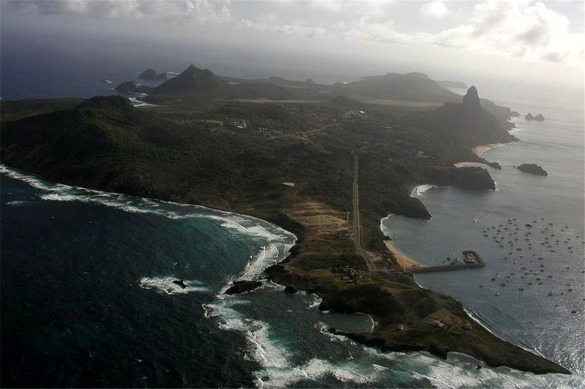
Another UNESCO World Heritage site, the beautiful, sun-drenched archipelago that lies 220 miles off Brazil’s northeastern coast is considered by most Brazilians to be the southern hemisphere’s answer to Shangri-la. The fiercely protected tropical national park consists of 21 islands and islets, with six principal islands: Fernando de Noronha, Rata, do Meio, Lucena, Sela Gineta and Rasa. Home of a former prison, much of the plant life was cleared to prevent prisoners from building boats in which to escape but was replaced by later settlers.
“The real draw of the park, however, along with its tropical climate and its superb surfing beaches, is its highly diverse marine life.”
There are more than 230 species of fish, 15 coral varieties and five types of sharks, including the non-aggressive lemon shark, nurse shark and Caribbean reef shark here. The islands’ protected marine reserves house communities of sea turtles, albatrosses, and spinner dolphins, which can be seen every morning at sunrise returning in groups to the calm waters of the Baía dos Golfinhos (Bay of the Dolphins).
In November, tourists and scientists gather on the shores to observe male sea turtles competing for the affections of females. Due to the clarity of the water (90-120 feet of visibility), two of the most popular activities in the park are snorkeling and scuba diving, along with pastimes like hiking, surfing, boat tours and wildlife-spotting.
Learn more about South America:
Like this story? Sign up for the Daily Dose and get more BootsnAll in your inbox.
Photos by:Vadim Petrakov, Matt Lament, all others by the author and may not be used without permission







